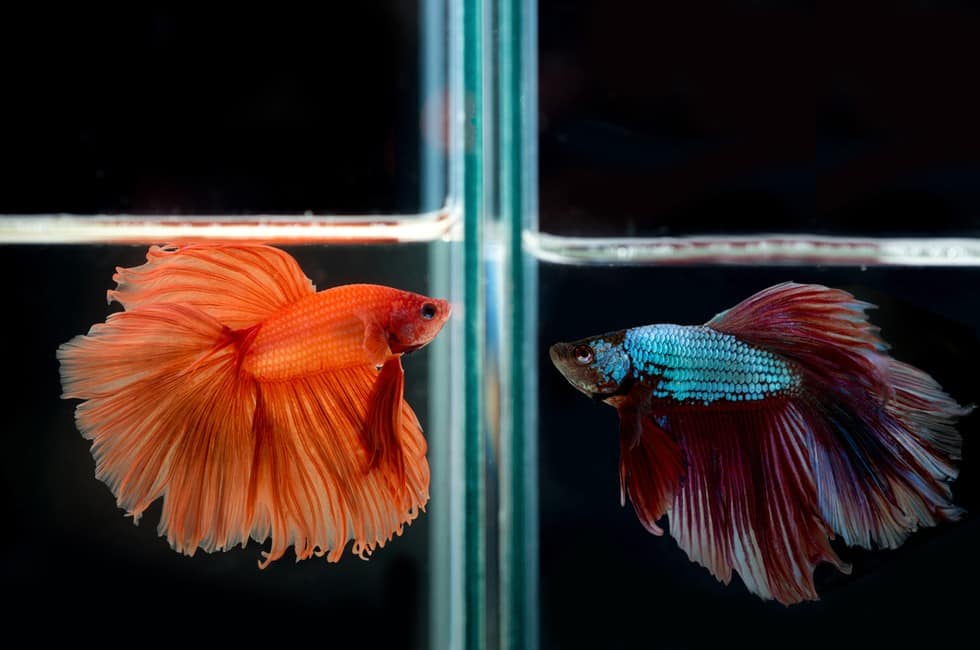The Betta fish also called the Siamese/Japanese fighting fish are well known for their aggressive behavior and for their brilliant colors. Bettas are widely available at various pet stores nationwide.
The question “Can a Male and Female Betta lives together” has been trending for some times now. In this article, we are going to be doing justice to the questions. The answer is NO. Betta fish are known for being quite aggressive; the males are territorial and must be kept in separate tanks. The females can still coexist together.
The Bettas, unlike many other fishes, are not schooling fish. They will always fight with one another. They prefer to swim alone and you need to provide a hiding place in their habitat for them to hide. They do not behave like schooling fishes.
Most Fish pet lover always wants to add a betta to their collection because they do not require much space and they are fun to watch.
Bettas also have gills which give them the ability to breathe oxygen directly from the air. Most fish lovers usually make the mistake believing that betta fish should be kept in a lonely environment.
As stated above, the female bettas can be kept together but the males should be placed singly in an aquarium setting with the perfect tank mates, and not another male betta because they would fight due to their territorial nature.
Let’s have a quick look at how to identify and differentiate between a male and female betta. You need to know how to identify them before you can make the perfect decision on what you want to do. Information is power and in this article, you will get the right information that you seek.
The male bettas are usually bigger than the female bettas. The males grow to about 2.5 – 3 inches in length while the females grow to about 2-21/4 inches. The male appears larger and longer, but they are thinner than the female bettas.
The fins and tails is a unique feature for identifying them. The fins and tails are among the features that attract fish lovers to bettas. The females possess smaller tins than males. The males have long, flowing fins and tails that shake as they swim.
The male bettas are brighter and they display flamboyant colors than the females. The color might not be the perfect determining factor to differentiate bettas, because the females might display.
Although, all betta fish, both the male and female betta have beards which are located below their gill plates. A male betta’s beard is large and quite noticeable while the female’s beard is small and you might not see it unless you look at it very closely.
Having read how to identify the male and the female betta, let us address some questions.
Can you put a Male and Female Betta Fish Together?
In pet stores, this is one of the most common questions about Betta Fish that fish pet lover ask. They are always worried about how to breed them. Yes, they are right, if bettas must reproduce, they must live together.
In this case, the male and female bettas will have to live together temporarily for the purpose of breeding. This is something you cannot do yourself; you need the assistance of an expert to put you through. The experience is important and vital in breeding bettas.
More: How to Clean a Betta Fish Tank
Can a female kill a male?
As a fish pet lover, if you decide to keep a male and female betta fish together in the same tank, you will end up killing one of them because there is a high probability that the male betta will kill the female betta.
To solve the problem of breeding, you need to introduce them gradually by first placing them in adjacent tanks. The process should not be a sudden one. It requires some laid down plans to carry it out.
You can keep them in the same tank and separate them with the help of a divider and watch them closely for a few days. You can then remove the divider when the male tries to build a bubble nest for the eggs.
Note that the betta courtship is aggressive. Once all the eggs are in the bubble nest, the male might try to attack the female. You should separate them immediately after breeding.
Can Females be kept together?
Yes, Females can be kept together in a single aquarium. When female bettas live together, the group is called a sorority. To make this possible, you need to properly set-up the aquarium and introduce the betta fish properly.
Although female bettas are also territorial, they are more social than males. The female betta sorority should not contain more than 4-5 fish for a medium-sized tank.
For bigger tanks, they should not be more than ten (10). If you want to start a sorority on your own, you need to do some extra research to make your decision. Keeping a sorority takes a lot of time and they require a lot of space.
Having 10 gallons of water for the first Betta is usually recommended and 5 gallons more for an additional Betta fish.
If you are using a small space, then you need to watch your bettas more closely. A large space is usually recommended so that they would not bump into one another while swimming in the aquarium.
Setting up a female sorority might look easy, but there are certain steps that should be followed:
- Select bettas that are similar in size and age
- An aquarium size of 20-30 gallons is always recommended
- An aquarium filter and aquarium heater is required
- Maintain the water temperature around 76-80F
- Feeding is important
At this stage, if you want to add any female betta to the sorority, you don’t just add it. It is advised that the female betta come from the same hatch.
This is very essential because there will be fewer chances for them to get aggressive with one another if they are of the same fry hatch. Also, If they are of the same age, they will be able to grow up together in the aquarium.
Can one Male Betta Live in a Sorority?
Yes, Male bettas can live in a sorority. But, you can also keep them with other fishes. You can do your research to know the perfect tank mates for the male betta fish.
Because of their territorial nature, you need to provide a lot of space for them to swim around and places for them to hide in the aquarium like caves.
It is important for you to note that, before you can introduce them to a sorority, the sorority needs to be well established first. The system needs to be balanced between the females or else, all you want to do is destabilize the aquarium.
What If I want to Put Two Male Bettas Together?
You can put two bettas together in a specially built tank with dividers. There are tanks that can support having two bettas together. An example is Minibow, it has a divider. You can always get one when you need it.
The only disadvantage is that the divider will reduce the amount of space available for each male betta. But, it will save you the cost of buying two separate tanks. You can also get a custom divider for your tanks. Male bettas cannot share the same habitat without a divider.
Let’s have a look at the Perfect Betta Fish tank mates: You might decide not to form a sorority, having them live with other aquatic organisms is another option.
Do you just pair them up with any kind of fish? Absolutely NO. Keep reading to find out the appropriate fish tank mates for bettas.
Under the right condition and environment, there are many betta fish tank mates that can live with male or female bettas in the aquarium. This scenario is known as a community tank and it can house more than two kinds of species.
Due to their territorial aggression, they cannot cohabit with any tank mate. They all have their unique personality and temperament; you need to be aware of what to pair them appropriately.
Keeping betta fish with other kinds of fish can be cunning, but also easier, if you know what you’re getting yourself into. When introducing your betta fish to any new environment, it is advised that you have an extra tank in case of an emergency.
You might need to remove your betta fish due to some safety reasons. You should also watch the aquarium more closely for at least 72 hours to see how they are performing.
Some Tank Mates for Betta Fish
Below are some common fish tank mates for the betta fish, we have also provided short information about the individual species.
Mystery Snails
Mystery snails (Pomacea Bridgesii) are one of the best tank mates for both male and female betta. They don’t just beautify the tank, they feed leftovers and they clean up algae in the aquarium.
Because of their docile nature, they are perfect for bettas. The adult mystery snails can grow up to 2inches in length. The mystery snails can also live up to 1year.
Feeder Guppies
Feeder Guppies (Poecilia Reticulata) are raised for food for bugger fishes. They do not have long fins. They are also perfect to serve as tankmates for the betta. They can live in the same PH and temperate range with the betta fish. They are easy going, so they cannot irritate/attack your betta fish.
Ghost Shrimp
As the name implies, the Ghost Shrimp (Thalassinidea) is invisible in the tank but can be seen when you check it more closely. The Ghost Shrimp are easy to keep, and they help to clean the tank by eating leftovers.
The adult Ghost Shrimp can grow up to 1.5 inches. Under normal condition, they can live up to 1.5years. The Ghost Shrimp are fun to watch.
Cory Catfish
The Cory Catfish are easy to maintain, they live well in the same water conditions with the betta fish. The Cory Catfish love to stay at the bottom and feed on leftovers thereby cleaning the aquarium. They can live alone and also in a group of 4.
The adult Cory Catfish can grow up to 2.5 inches in length. The Cory Catfish can also live up to 2-3 inches. They have a gentle temperament and this makes them a perfect tank mate for the betta fish.
African Dwarf Frog
The African Dwarf Frog (Hymenochirus Boettgeri) is suitable for the betta fish because of their gentle personalities. You do not need to spend more on maintaining them. They can live up to 5 years.
The African Dwarf Frog can grow up to 2.5 inches in length. The males are smaller than females. They are very active and they love to move around the tank. They come to the water surface to gulp for oxygen with the help of their lungs, so you need to provide a stand for them in the water.
Conclusion
Having gone through this article, we hope you have been able to get some new insights about what you need to know about betta fish. Just keep it in mind to follow the necessary steps we stated.
Are you currently keeping a betta fish and you want to share your experiences with us?
Let us know what you think, leave your comment in the section below!
Thank you and Happy Betta keeping.


